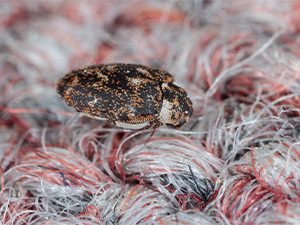
Carpet beetles, small and inconspicuous insects, may seem harmless at first glance, but they can wreak havoc on your carpets and other household items if left unchecked. These pests are known for their uncontrolled appetite for natural fibers such as wool, silk, fur, and feathers. Despite their name, they don’t only infest carpets but can also inhabit other textiles, upholstery, clothing, and even food products.
Carpet beetles typically invade homes through openings around windows and doors, as well as through vents and utility pipes. Once inside, they lay their eggs in dark, out-of-the-way areas such as under furniture, along baseboards, and in carpet fibers. The larvae, which are the most destructive stage of carpet beetle life cycle, hatch from these eggs and begin to feed on organic materials within the home.
Infestations often go unnoticed until damage becomes noticeable. Signs of carpet beetle activity include irregular holes in fabrics, shed skins, and fecal pellets resembling grains of sand.
To effectively eradicate carpet beetles from your home, a combination of preventive measures and targeted treatments is necessary.
Here are some steps you can take:
- Vacuuming: Vacuum your carpets, rugs, and upholstery often, paying special attention to areas where debris tends to accumulate. This helps remove eggs, larvae, and adult beetles, reducing the likelihood of infestation.
- Seal Entry Points: Seal any gaps or cracks around doors, windows, and utility openings to prevent carpet beetles from entering your home.
- Reduce Clutter: Decluttering your living space cuts hiding spots for carpet beetles and makes it easier to spot signs of infestation.
- Wash and Dry Clothing: Launder clothing, bedding, and other washable fabrics regularly in hot water and dry them on high heat to kill any eggs or larvae present. Not all fabrics or clothes can tolerate hot water and high heat. These may need to go to the dry cleaner.
- Store Items Properly: Store infrequently used clothing, blankets, and other textiles in airtight containers or garment bags to protect them from carpet beetles.
- Use Insecticides: Consider using insecticides labeled for carpet beetle control in areas where infestations are severe. Follow all safety instructions and precautions provided on the product label.
- Professional Help: If infestations persist despite your efforts, seek help from a pest control professional who can assess the situation and recommend proper treatment options.
- More professional Help: If you used any kind of pesticide or insecticide on your carpet to resolve the situation, have your carpets cleaned. Residue from the chemicals can attract and capture dirt and debris, making your carpets look old and worn.
By following these guidelines, you can prevent and address carpet beetle infestations, protecting your carpets and other fabric items from damage. Consistent maintenance is the key to keeping these unwanted pests at bay.
FYI:
- Carpet beetles are found all over the U.S and the world but are more prevalent in warmer climates.
- While they prefer natural fibers like wool, cotton or silk, they will feast on synthetic fibers as well.
By Sharon Koehler. This article is one of a series of articles written and published on behalf of Surface Care PRO Partners.




